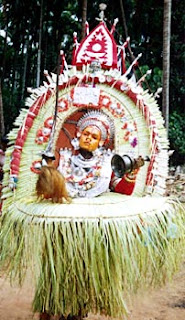"Nambinakalegu imbu korpa, Satya gendadu korpa.
Satyodu bathinakleg tigaled saadi korpa,
Anyayodu battinagale suryodu saadi tojawa"
Bhoota Kola (Holy Spirit Worship)
Above quotes are powerful tulu words which can be commonly hear in 'Nema' (tulu function).
Bhoota Kola is a form of 'Bhuta Aradane' or worship of holy spirits , widely followed in South Canara & parts of Kerala. Bhoota or Daiva is a holy spirit and Bhoota Kola is all about paatri ( impersonator ) also called as 'Nalke' in tulu, getting possessed by holy spirit.
This event mostly happens anually.It is a worship which starts after the dusk and can go on till the early morning.
In short to sum it up, Bhoota Kola is system of rituals,social gathering, miraculous healing of ailments and solutions to problems.
The holy spirit is also known as 'Daiva'.Mostly this is relevant to few families which have been following this for hundreds of years.Such families might have a small temple like structure built which is known as 'Bhootada Gudi'.
These families rely on the holy spirit to shower them with good fortune and protect them from the evil.

Yakshagana
Yakshagana is a classical folk art form of the state of Karnataka in India mostly popular in the districts of North Canara, Shimoga, Udupi and South Canara.
Yakshagana is the most famous theatre form of Karnataka. In Yakshagana theatre, dance, music, dialogue all are harmoniously blended.Its main attractions are its gorgeous masks and costumes and themes from the Epics of India.
This would be considered to be a form of opera in western eyes. Actors wear costumes and enact the various roles. Traditionally, Yakshaganas would go on all night.
A Yakshagana performance begins at the twilight hours with the beating of drums for up to a couple of hours before the 'actors' get on the stage. The actors wear resplendent costumes, head-dresses, and painted faces which they paint themselves.
Kambala (Buffaloes race)
A popular sport of rural Mangalore, it is a kind of buffalo race. Immediately after Gurji, it is conducted in alluvial fields, specially flooded after the harvesting season.
Starting at noon after prayers and invoking blessings from mother earth, the Arasu or Chieftain pours milk onto the fields to symbolically inaugurate the race.
It is a test of speed for the specially trained male buffalo pairs and endurance as well as grit for the jockey.
The jockey, clad only in a skimpy loin-cloth has to run with the animals or do a balancing act on a wooden plank attached to the whip.
The beating of Tase drums invite the crowd, while Kombu trumpets signal the start.
The race categories are solo (time based)/ competitive/ highest water splash creation. Spectators have to brave the insects and the showers of muddy water, but the biggest risk is of being run over by the animals.
Koti Chennaya : Tulunada Amaraviraer
Koti and Chennayya are legendary twin heroes from BILLAVA family characterized in the Tulu epic by same name, which is considered one of the two truly long epics of the Tulu-speaking people.
The story of these heroes may be taken to roughly five hundred years back, when reference to Ballalads were made in the Tulu Padana.
Koti Baidya and Chennaya Baidya were born to Deye Baidethi of Billava family of historical Tulunadu in the state of Karnataka.
Owing to the brothers heroic deeds,they are worshiped and remembered as protectors. They died while fighting with the enemies near Yenmoor.
Memorials called Garadi has been built in the name of Koti and Chennayya all over Tulunadu. Garadis can also be considered as Billava temples. The term Garadi is derived from word Garodi which means gymnasium..
Once in a year festivals called Nema is celebrated in these Garadis and village people assemble here praying for the well-being of all.
The valiant twins are also known as Karnika purushas. Even till date they are worshiped in garadis and not at homes which indicated the high esteem they are held in since they fought for the truth.
Nagamandala (Snake Dance)
Snakes, especially the cobra have been revered from ancient times all over India. Due to their mysterious appearances, slithering movements, snakes had always been held in awe in India. Snakes find mention in famous religious epics like Mahabharata, Vishnu Purana etc.
Hindu Gods like Vishnu and Shiva have been associated with snakes. According to Hindu mythology, Lord Vishnu takes rest under the shade of the giant snake, Adisesha. Lord Shiva wears a snake around his neck.
The snake worship rituals practiced in Tulu Nadu are quite unique and different from the other rituals. Snakes have their own snake shrines in a corner of the garden, often under a neem tree known as Nagabana. This is usually a stone with snakes carved on it. Accordingly, nobody is allowed to chop the tree near the Nagabana.
Kori Katta (Cock fight)
A common event in the vicinity of Mangalore, Cock fight. Hundreds of people flock around the scene and participate in the event. Lots of betting takes place and is full of fun. Cock fight also called as Kori Katta in Tulu language.
Some of the names for the cock usually we call in Cock fight are Bolle, Maipe, Karbolle, Kemmaire, Kadle, Uriye, Kupule and Peradinge. Now you are watching the image of Bolle vs Maipe fight and the Bolle (whight) striking on Maipe .
This sports is usually conducted in the vicinity of temples and still goes on albeit surreptitiously and furtively in many surrounding parts of Mangalore. There may be a religious basis for this sport as I have seen this being conducted during festival seasons.










